I know an elder who entered the crypto world with 100,000 yuan; it is now worth 42 million yuan. He once told me something that enlightened me. He said, 'This market is filled with a mob; as long as you control your emotions, this market is an ATM!'
In the crypto world, trading strategies are your 'secret weapon'. The following mnemonics are crystallizations of practical experience; be sure to save them!
Entry Chapter: Testing the waters in the crypto world, preparing to proceed; steadily entering the market, rejecting reckless moves.
Sideways Chapter: Low-level sideways movement creates new lows; heavy positions for bottom fishing are timely; high-level sideways movement leads to spikes; decisively sell without hesitation.
Volatility Chapter: Sell when the price rises, enter quickly when it drops; observe during sideways movements, reduce trading activities. Sideways means replacing declines with horizontal movements; hold your assets tightly; a surge may happen in the next second; during rapid surges, beware of sharp declines and be ready to secure profits; slow declines are the right time for gradual position increases.
Timing Chapter: Do not chase highs, do not sell; do not jump into the water, do not buy; do not trade during sideways movements. Buy on bearish candles, sell on bullish candles, and operate inversely to stand out. Buy in the morning when there is a significant drop; sell when there is a significant rise. Do not chase highs in the afternoon when there is a rise; buy the next day when there is a significant drop in the afternoon. Do not cut losses when there is a significant drop in the morning; if there is no rise or fall, take a break; seek to break even on locked positions; excessive greed is not advisable.
Risk Awareness Chapter: Calm lake surface hides high waves; there may be big waves ahead; after a significant rise, a retracement is inevitable; K-line shows a triangle for many days. In an upward trend, watch for support; in a downward trend, watch for resistance. Full position trading is a big taboo; acting stubbornly is not feasible; knowing when to stop in the face of uncertainty is essential, grasping the timing to enter and exit.
Trading cryptocurrencies is essentially about trading mindset; greed and fear are the real enemies; be cautious when chasing highs and cutting losses; maintain a calm and composed demeanor.
In addition to the mnemonics, I have compiled several super practical trading methods that can benefit both novice traders and seasoned players.
Oscillation trading method: Most market conditions are in an oscillation pattern; using high sell and low buy within the box is the basis for stable profits. Utilize the BOLL indicator.
Combine box theory with technical indicators and chart patterns to accurately identify resistance and support. Follow short-term trading principles and avoid greed.
Trend change breakout trading method*: After a long period of consolidation, the market will choose a direction; entering after a trend change can yield quick profits. However, precise trend changes are required.
Unilateral trend trading method*: After the market breaks out of the range, it will form a unilateral trend, and trading in the direction of the trend is key to profit. Enter trades during pullbacks or rebounds, referencing indicators such as candlesticks, moving averages, BOLL, and trend lines; mastery of these will enable you to navigate smoothly.
Resistance and support trading method*: When the market encounters key resistance and support levels, it often gets blocked or receives support; entering trades at this moment is a common strategy.
Use trend lines, moving averages, Bollinger Bands, parabolic indicators, etc., to accurately determine resistance and support levels.
Retracement and rebound trading method: After significant rises or falls, a brief retracement or rebound will occur; seize the opportunity to profit easily. The main basis is to judge based on candlestick patterns; good market sense can help you accurately grasp highs and lows.
Time period trading method: The morning and afternoon sessions have small fluctuations, suitable for conservative investors; although the time to profit from trades is long, it is easier to grasp the market. The evening and early morning sessions have large fluctuations, suitable for aggressive investors; they can profit quickly but with higher difficulty and strict requirements for technical and judgment skills.
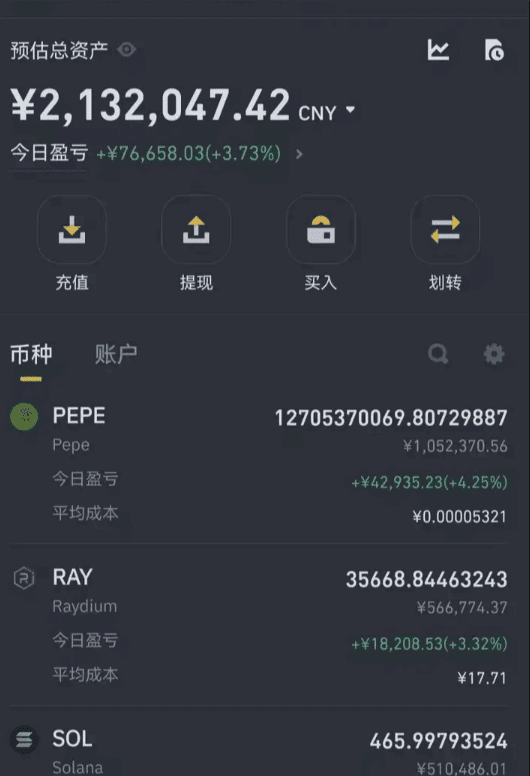
1. Introduction
At this stage, you may have already mastered knowledge of many chart patterns, such as double bottom patterns, ascending triangle structures, and inverse head and shoulders patterns, as shown in the figure below.

However, as you understand, not all chart patterns will consistently perform effectively. In this situation, what measures should you take when these chart patterns fail to achieve the desired effect? As shown in the figure below.
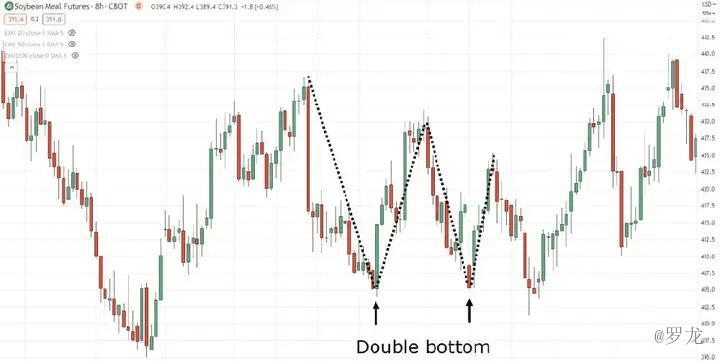
When the scope of involvement expands further, how will you take action? As shown in the figure below.
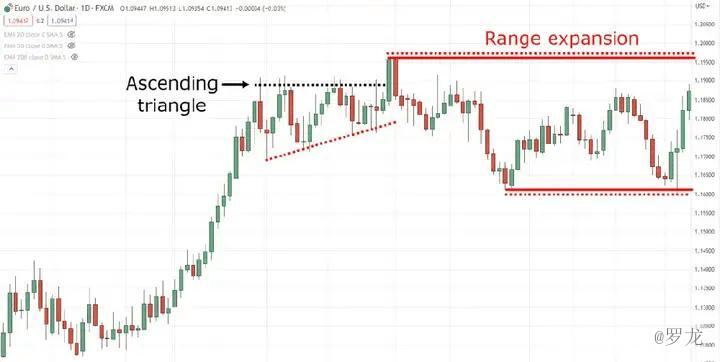
At that time, what kind of trading activities do you plan to engage in on the market? As shown in the figure below.
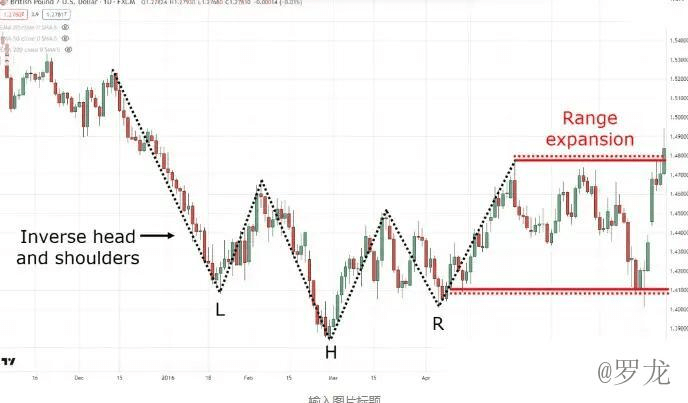
It is at this moment that the triple bottom pattern reveals its unique application value, as shown in the figure below.
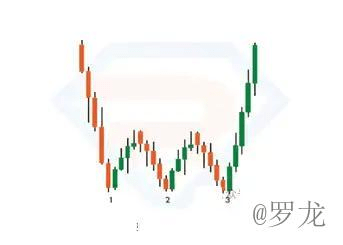
The triple bottom pattern is one of the rarer chart patterns in the current market; however, amidst market volatility, it remains an indispensable weapon in the trader's toolbox.
In this guide, you will learn the following:
(1) A detailed guide to the operational mechanism of the triple bottom pattern;
(2) How to avoid misjudging the triple bottom pattern (and appropriate measures to take in this case);
(3) Correct trading and analysis methods for triple bottom patterns;
(4) A step-by-step procedure for accurately defining and executing triple bottom trades.
2. What is a triple bottom and how does it work?
The triple bottom pattern is like a talented superstar taking the stage, beginning at the neckline, which is the support for the entire structure, as shown in the figure below.
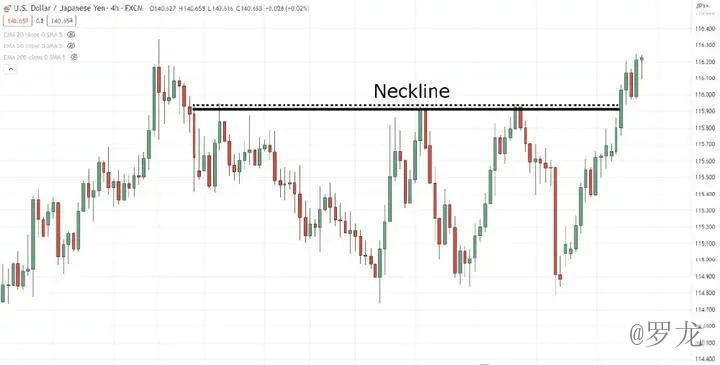
Subsequently, in the dazzling complexity presented by the market, the three bottoms emerge sequentially, each playing an indispensable role in this captivating pattern, as shown in the figure below.
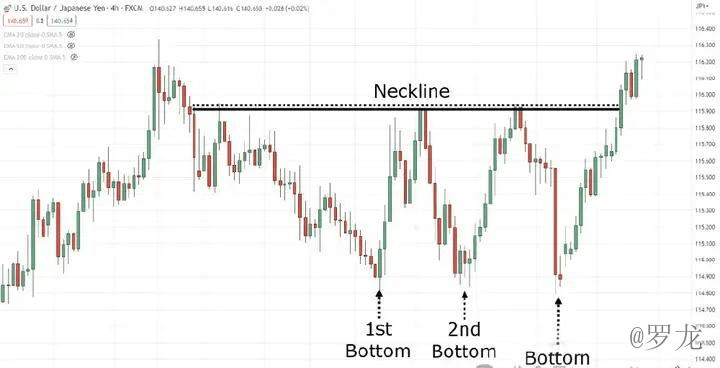
This is like a meticulously choreographed synchronized dance, drawing attention and laying the foundation for potential trading opportunities; this pattern is indeed easy to identify.
Now that you understand the appearance of this pattern, how is the triple bottom pattern formed? If you are pondering this question, you are moving in the right direction, as understanding 'why' it happens is often more crucial than merely knowing 'what' happens.
In this guide, we primarily discuss three reasons leading to the formation of the triple bottom pattern.
(1) Market indecision
Envision the market as a capricious individual whose decision-making process is indecisive, similar to a friend who can never decide where to go for dinner or what movie to watch. Thus, the triple bottom pattern emerges, stemming from the instability caused by market indecision, as shown in the figure below.
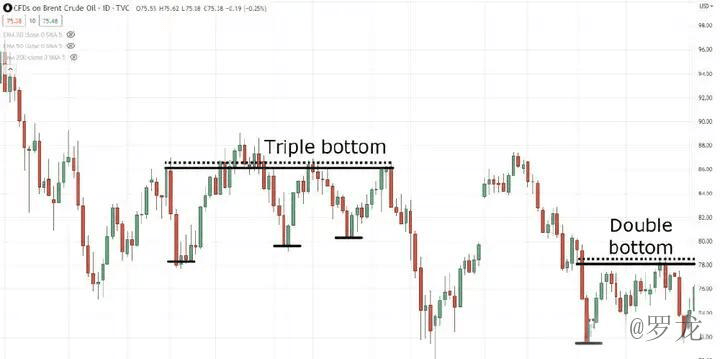
Just as the market seems to say: I can't decide which path to choose, have you noticed how the price range in the previous example continually expands? This is like a paused moment of confusion; however, it provides traders like us with the opportunity to utilize the impending market decision. Therefore, we are essentially discussing that the triple bottom pattern is a direct product of market indecision.
(2) Development takes time.
This pattern tends to develop gradually with its unique rhythm; however, this makes it like a carefully slow-cooked dish, and the waiting process is worthwhile, just like watching a suspense movie where well-informed viewers can foresee the climax of the plot. The market is testing your patience, teasing you with its subtle fluctuations; for those willing to wait patiently and observe carefully, the triple bottom pattern offers a potential opportunity for substantial profits. Therefore, stay calm and let this pattern reveal its enticing trading opportunities in a timely manner. In fact, to further illustrate this principle, you can effectively leverage the triple bottom pattern when the following situations arise.
(3) You missed the double bottom pattern.
If you missed the double bottom pattern, as shown in the figure below.
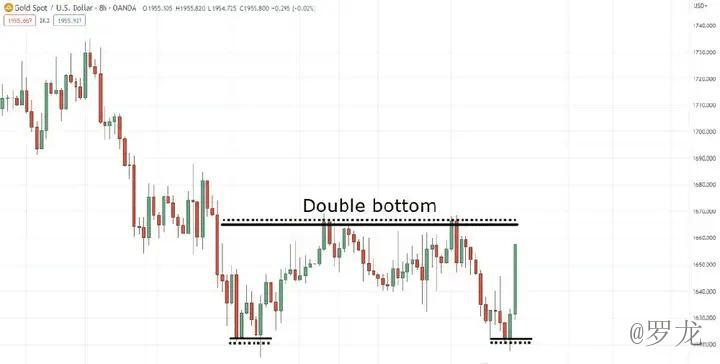
You need not toss and turn in regret, for the triple bottom pattern can now turn the tide, presenting you with another opportunity to participate in the market, as shown in the figure below.
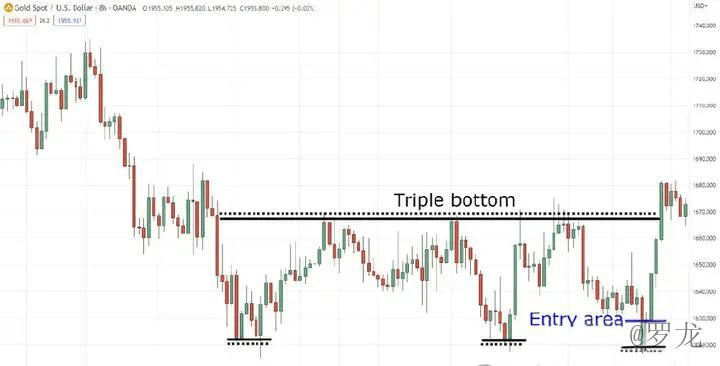
This is akin to unexpectedly discovering a hidden treasure chest in despair, where all hope seemed lost, providing an additional entry opportunity due to this pattern.
Now, I understand that trading the double bottom pattern may seem more appealing, but the key is whether you can seize the opportunity. For cautious traders seeking more confirmation, closely monitoring the triple bottom pattern is worthwhile; it is a pattern that can bring redemption, excitement, and substantial profits, adding value to your trading chart. Now that you have understood the appearance of the triple bottom pattern and its operational mechanism, I will explain under what circumstances you should not trade this pattern. Remember, all trading patterns have their advantages and limitations.
3. The biggest mistake when trading triple bottoms: Avoid these traps.
(1) Error 1: Trading in the middle of a triple bottom pattern.
First of all, trading within a price range is like trying to wear a pair of overly tight jeans, which is inevitably uncomfortable. Remember, triple bottom patterns usually form in situations of market indecision, where market behavior resembles a child hesitating with numerous tempting choices in a candy store. Therefore, one should resist the impulse to frequently enter and exit during the formation of the pattern; instead, patiently wait for the market to make a clear decision.
In summary, avoid trading during the intermediate stages of the pattern establishment, as shown in the figure below.
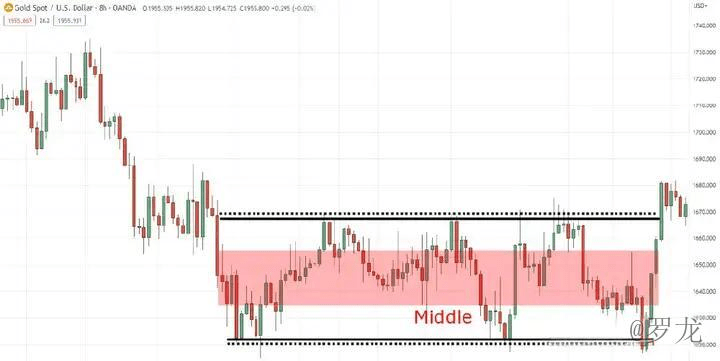
Please focus on the value area, which is the so-called support and resistance levels, as shown in the figure below.
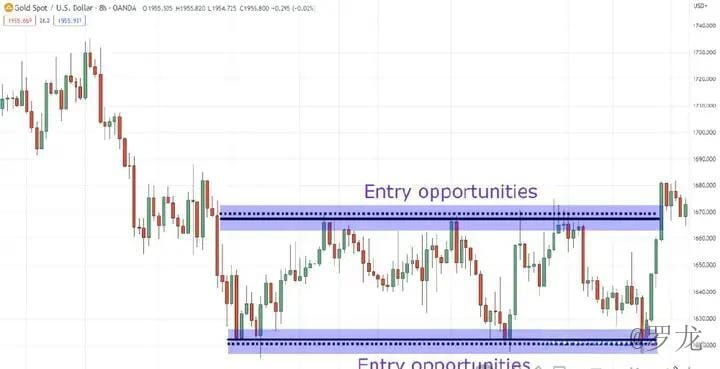
(2) Error 2: Blindly trading highs and lows.
What does this mean? Should we avoid trading not only the middle part of the triple bottom pattern but also the highs and lows? You should know that the triple bottom pattern is famous for its frequent false breakouts, as shown in the figure below.
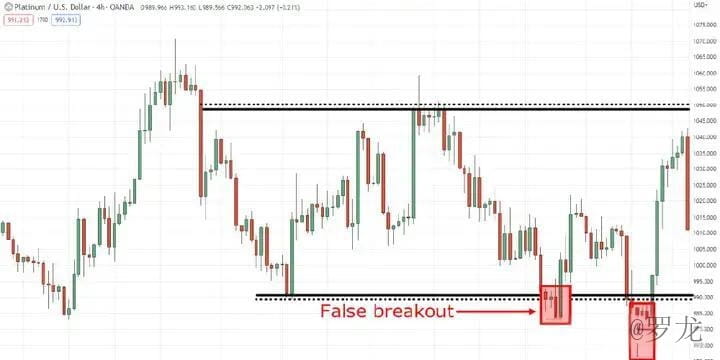
This is due to the inherent characteristics of range-bound markets; they expand and contract, and triple bottoms may even evolve into quadruple bottoms. This is like a prankster lurking in the shadows, ready to jump out and give you a fright. Therefore, do not blindly follow price peaks and troughs like an ignorant squirrel; instead, wait for market confirmation before trading, which means you should patiently wait for the actual breakout to occur after the third bottom, as shown in the figure below.
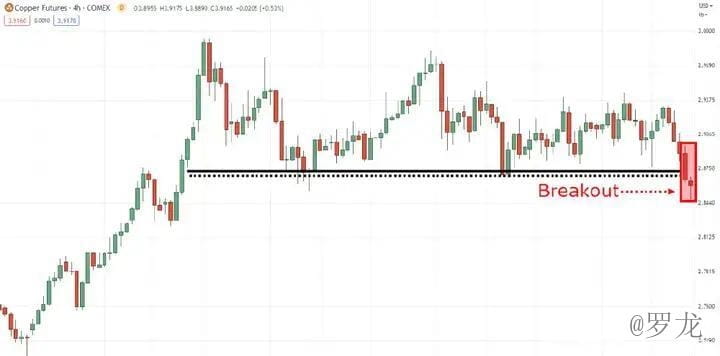
And it should be confirmed by the closing price when entering this range, serving as valid confirmation of the formation of the third bottom, as shown in the figure below.
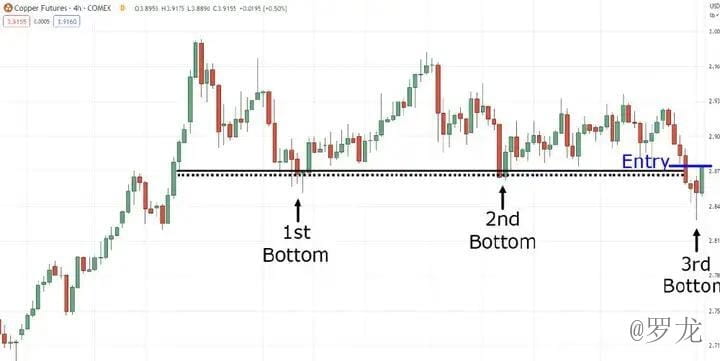
Therefore, reaching highs and lows does not constitute a sufficient reason to trade immediately; rather, you should remain vigilant and wait for the necessary additional confirmation signals.
(3) Error 3: Using double bottom patterns to judge market direction
Now, let’s clarify one point to correct a common misunderstanding. While the triple bottom pattern may play a key role in the market, it does not possess the prophetic ability to predict market direction. This means that even if you identify a triple bottom pattern, the market has no obligation to break out to higher levels; the following situations may also occur, as shown in the figure below.
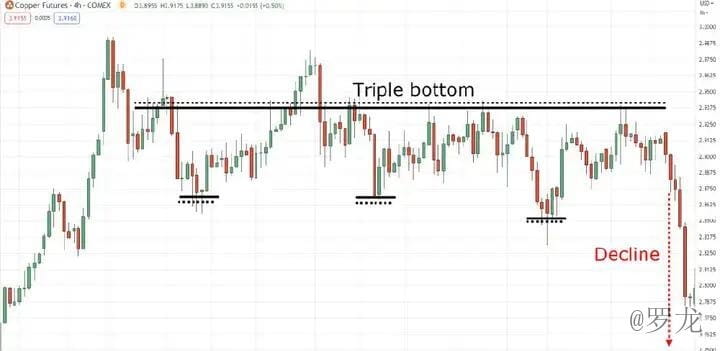
This is akin to hoping to predict tomorrow's lottery numbers through a crystal ball, which is nearly impossible. Therefore, do not rely solely on the triple bottom pattern to determine the market's subsequent trends; instead, analyze other relevant factors comprehensively and view the triple bottom pattern as one of the auxiliary tools, not the sole decision-making indicator.
(4) Error 4: Overly relying on 'textbook' triple bottoms.
When discussing the triple bottom pattern, do not be overly confined to the definitions in traditional textbooks, as shown in the figure below.
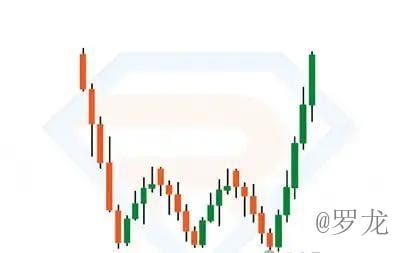
This pattern is like a chameleon, changing in form, with each turn bringing new surprises, indicating the existence of multiple effective triple bottom variants, as you have previously observed, as shown in the figure below.
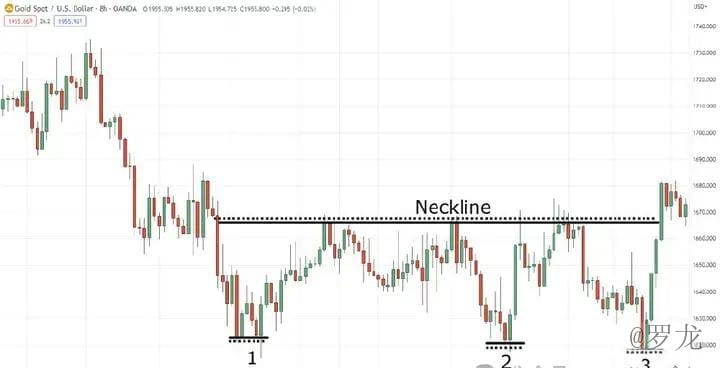
And this, as shown in the figure below.
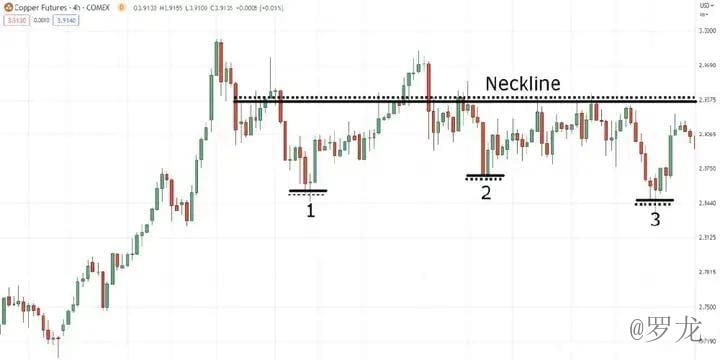
Therefore, let go of your rigid expectations of the pattern and appreciate the beauty of its diverse forms; the key lies in identifying those 'sharp bottoms' on the chart.
Now, you may be thinking: I know how to identify this pattern and what behaviors to avoid when trading; how should I proceed with trading? If this is your question, now is the time to showcase your trading skills, as I will reveal the three key market trends to pay attention to when trading triple bottom patterns.
4. Ideal strategies for successfully trading the triple bottom pattern.
(1) Ensure the triple bottom is within the existing upward trend.
By ensuring your trading actions align with the current market upward trend, as shown in the figure below.
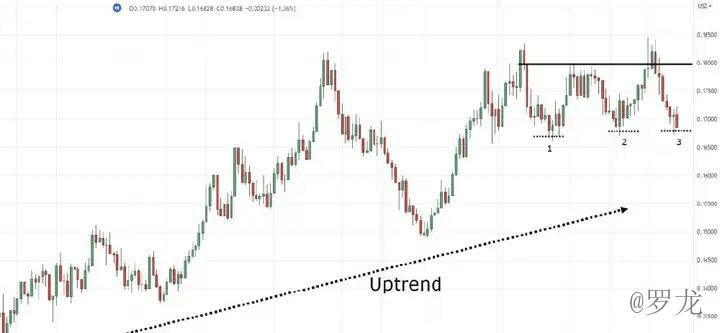
You are increasing your probability of trading success and moving in sync with the market's rhythm, focusing on this upward trend, just like an experienced dancer finding the ideal partner, ready to gracefully spin and immerse in the unfolding of the triple bottom pattern.
(2) Look for false breakouts or accumulations.
When you observe a false breakout at the third bottom, as shown in the figure below.
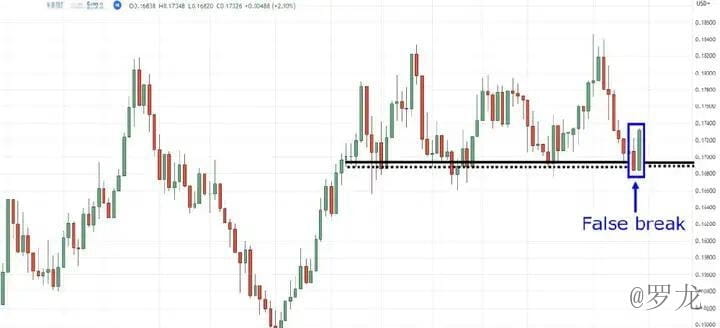
This is like noticing your dance partner pretending to be tired but then regaining energy with their talent, signaling that the pattern is primed and ready to capture the market's attention, as shown in the figure below.
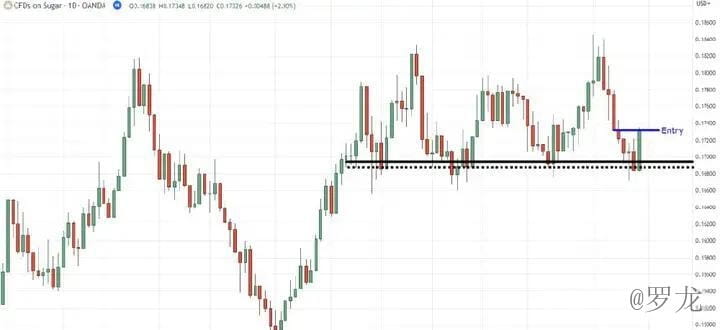
From another perspective, if you encounter the following situations: failed to seize the entry timing for the double bottom pattern, missed the trading opportunity for the false breakout of the triple bottom pattern, do not worry, for opportunities still await you. This is because if you observe a price accumulation phenomenon at the high point, as shown in the figure below.
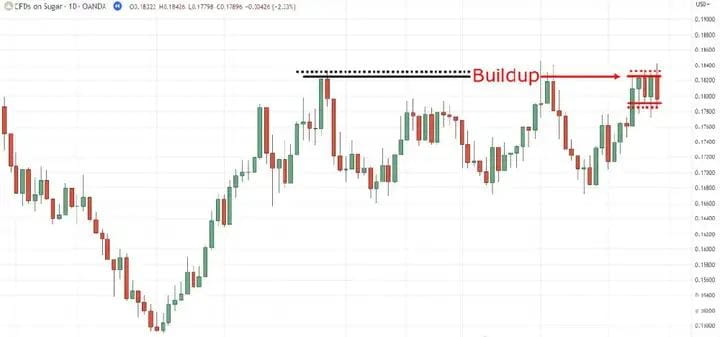
This is like witnessing the moment before an electrified elevator starts; this phenomenon indicates that the triple bottom pattern is preparing for a potentially energetic breakout, as shown in the figure below.
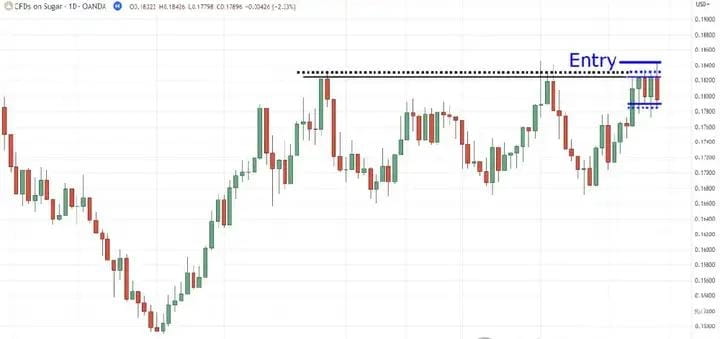
Therefore, keep an eye on these cutting-edge market trends and be ready to showcase your trading abilities on the market stage. At this stage, you have mastered all the necessary key elements to successfully execute triple bottom trades; however, as you well know, the effectiveness of these tools depends on how you apply them. If you have been trading similar double bottom patterns for a while, then you are well prepared. However, if you seek a concise guide on how to leverage triple bottom patterns for market discovery, trading, and trade management, please continue reading the subsequent content of this guide.
5. Mastering the triple bottom: A trading strategy that lets you dance in profits.
(1) Step 1: First, determine the upward trend within the daily timeframe.
Consider it as discovering the ideal rhythm, laying the foundation for an engaging performance, exploring those continuously rising highs and lows, symbolizing a strong upward trend, as shown in the figure below.
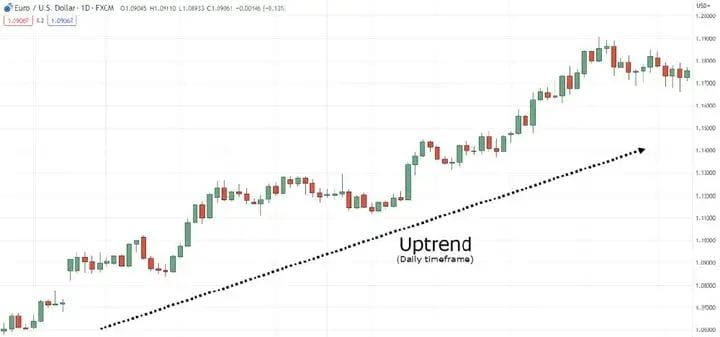
Once you confirm this upward trend, proceed to the next stage, closely following the market rhythm.
(2) Step 2: Identify potential triple bottoms within a 4-hour timeframe
At this moment, shift your focus to the 4-hour chart, where the potential triple bottom pattern will appear vividly. Compare this process to choreography, where each step carries a specific goal; identify the triple bottom pattern, which is formed by three different bottoms connected by the neckline, as shown in the figure below.
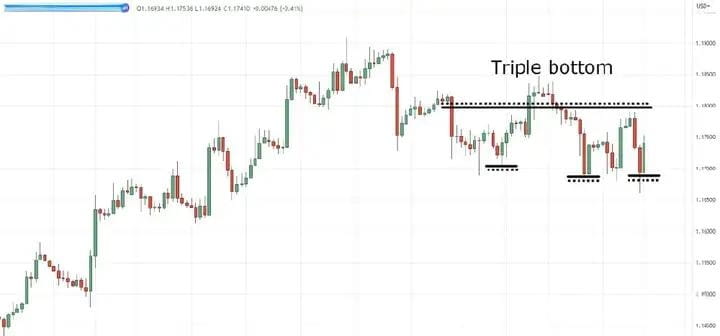
This is akin to observing a group of dancers synchronizing their steps, weaving striking patterns on the dance floor; once you identify this masterpiece of a triple bottom pattern, you should prepare to make precise trade entries.
(3) Step 3: Trade at three points of false breakouts.
This is akin to executing a stunning spin or quickly changing direction on the dance floor, making all the spectators admire; when the market briefly dips below the third bottom and then quickly rebounds, as shown in the figure below.
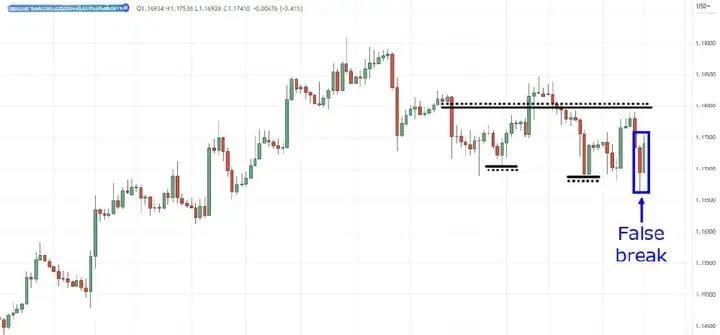
This is a sign that the pattern is primed and ready to become the market's focal point. So, like an experienced dancer, follow this momentum to join the trade, showcase your trading skills, and seize the market opportunity, as shown in the figure below.
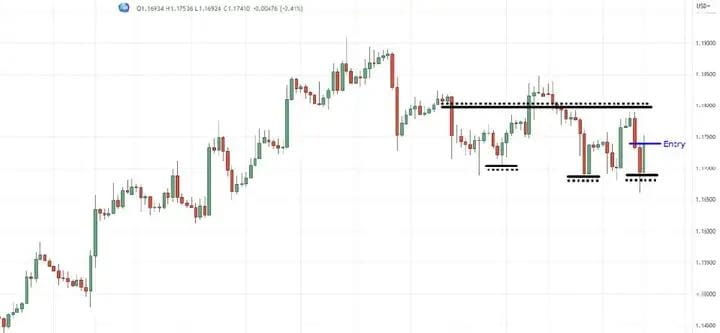
Grasping the timing is crucial; patiently wait for that false breakout to occur and take swift action.
(4) Step 4: Accumulation at the neckline with reduced scale
Now is the time to enhance your trading performance. You may wonder: how to achieve this? By gradually reducing your trading scale near the neckline, as shown in the figure below.
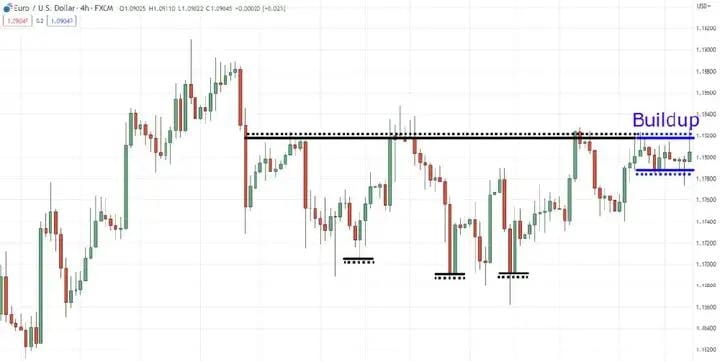 Consider it as a grand upgrade in choreography, where energy surges to new peaks; when the price decisively crosses the neckline, it signifies that the triple bottom pattern is about to unleash its full market potential. In this situation, how should you act? Simply put, you should increase your position size, expanding on your initial trade to maximize your profit potential, as shown in the figure below.
Consider it as a grand upgrade in choreography, where energy surges to new peaks; when the price decisively crosses the neckline, it signifies that the triple bottom pattern is about to unleash its full market potential. In this situation, how should you act? Simply put, you should increase your position size, expanding on your initial trade to maximize your profit potential, as shown in the figure below.
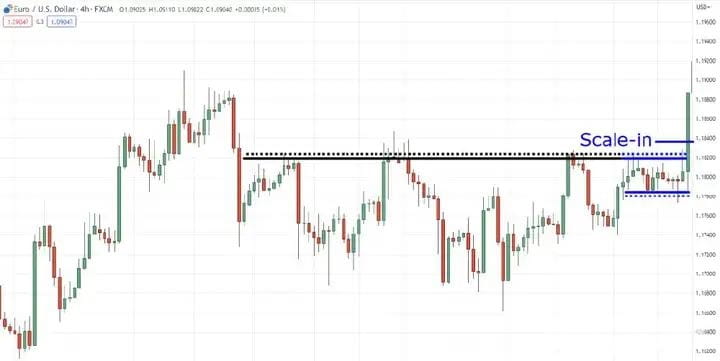
This is akin to the crescendo in a musical piece; the key is that this breakout provides investors an opportunity to ride the wave of victory.
(5) Step 5: Use the 20-period moving average for trailing stops.
Since you have ventured into this field, how should you manage it? In this case, I recommend using the 20-period moving average as a trailing stop tool, as shown in the figure below.
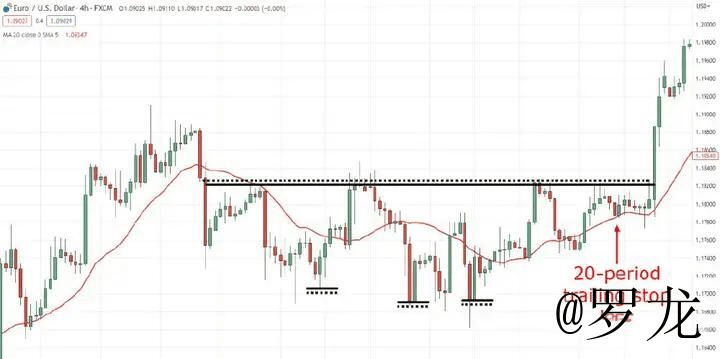
This indicator is like a trustworthy dance partner, ensuring your safety on the trading stage; as prices move favorably, use this dynamic indicator to adjust your stop-loss position to protect your profits, as shown in the figure below.
Here are other key points you should understand; you always have the right to choose between the 3rd and 4th stages. For traders inclined to take higher risks, you can choose to trade during the 3rd and 4th stages; if you are a more conservative trader, you can choose to enter the market when the price breaks the neckline (i.e., the 4th stage); if your trading style is somewhere in between, you might consider taking action in the 3rd stage rather than reducing your position, but rather expanding horizontally in the 4th stage.
Therefore, put on your trading 'battle shoes,' practice these steps, and let this simple triple bottom strategy become your ticket to trading success.
6. Conclusion
Below is an overview of the core points of this guide:
(1) The triple bottom pattern provides a second entry opportunity for traders who failed to seize the double bottom opportunity.
(2) It consists of a neckline and three distinct bottoms, typically forming during periods of market indecision and requiring a certain amount of time to develop.
(3) When trading triple bottoms, avoid common mistakes such as trading within a price range and overly relying on textbook patterns.
(4) The best trading method is to align with the current upward trend of the market and focus on false breakouts at lows or price accumulation at highs.
(5) A simple trading strategy includes identifying upward trends, discovering triple bottom patterns, trading false breakouts, adjusting position sizes during breakouts, and using the 50-period moving average as a trailing stop tool.
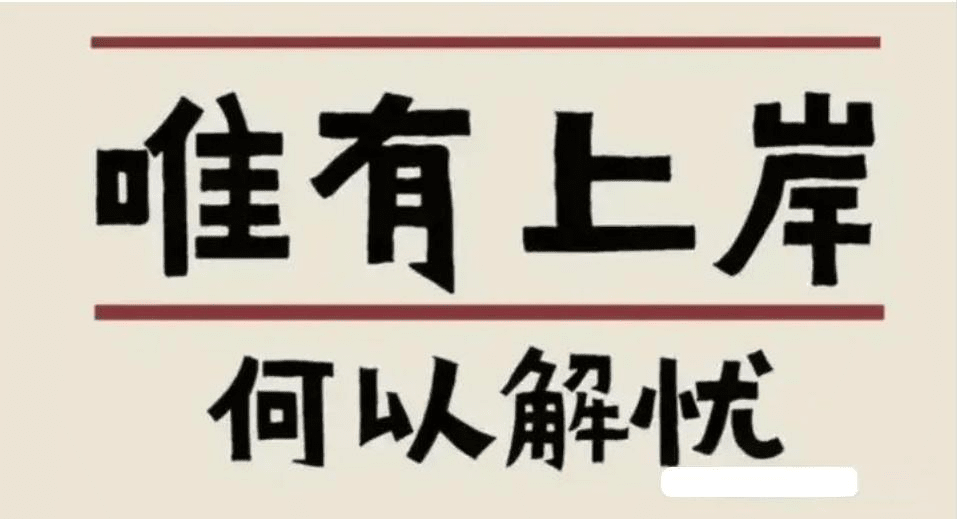
Simple and practical tips for trading cryptocurrencies, enabling you to profit steadily.
1. Invest in batches: Suppose you have 10,000 yuan, divide it into five parts, using only 2,000 yuan for each trade.
2. Testing the waters: First use 2,000 yuan to buy a cryptocurrency to test the waters.
3. Add positions after a drop: If the price drops by 10%, use 2,000 yuan to increase your position.
4. Take profits when it rises: If the price rises by 10%, sell some to lock in profits.
5. Repeat the cycle: Continuously buy and sell until funds run out or coins are sold out.
Strategic advantages: The benefit of this strategy is that even if the price of the cryptocurrency falls, you can remain calm. By entering in batches, you avoid the risks of a one-time investment. Even if the price drops by half, you are only gradually increasing your position. Each time you sell, you can lock in a 10% profit. For example, if you have 100,000 yuan and invest 20,000 yuan each time, you can earn 2,000 yuan each time.